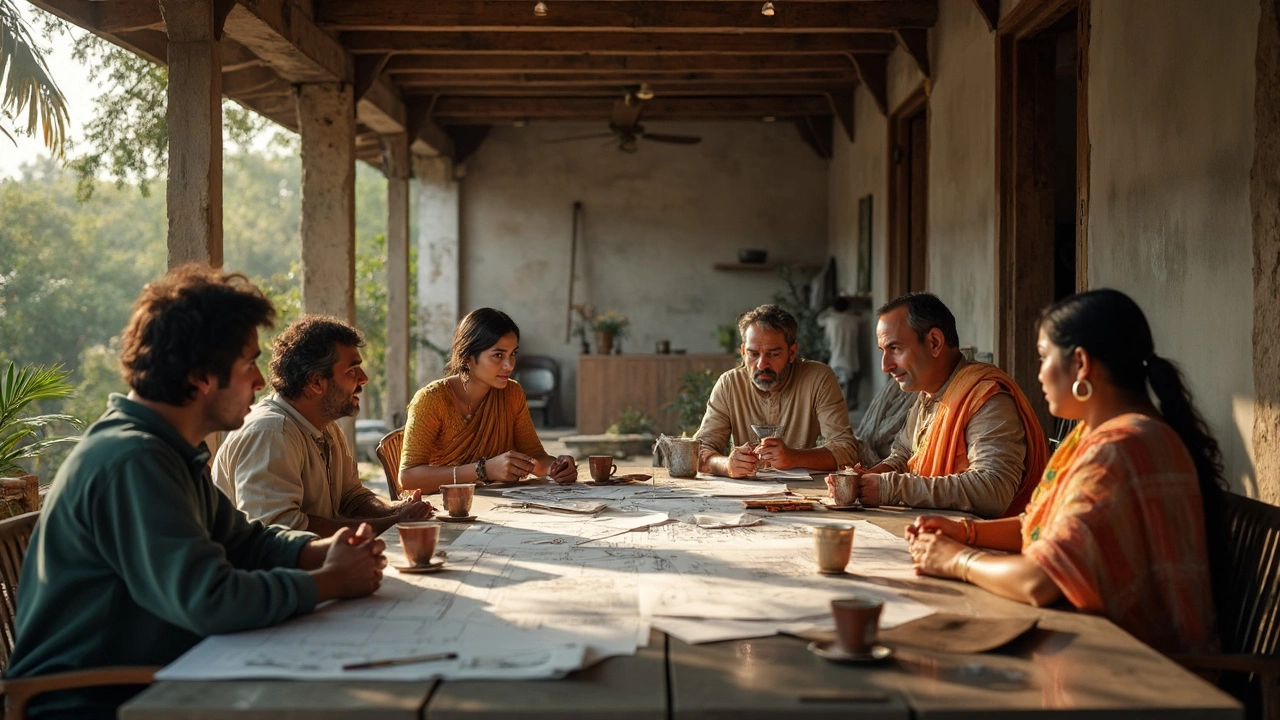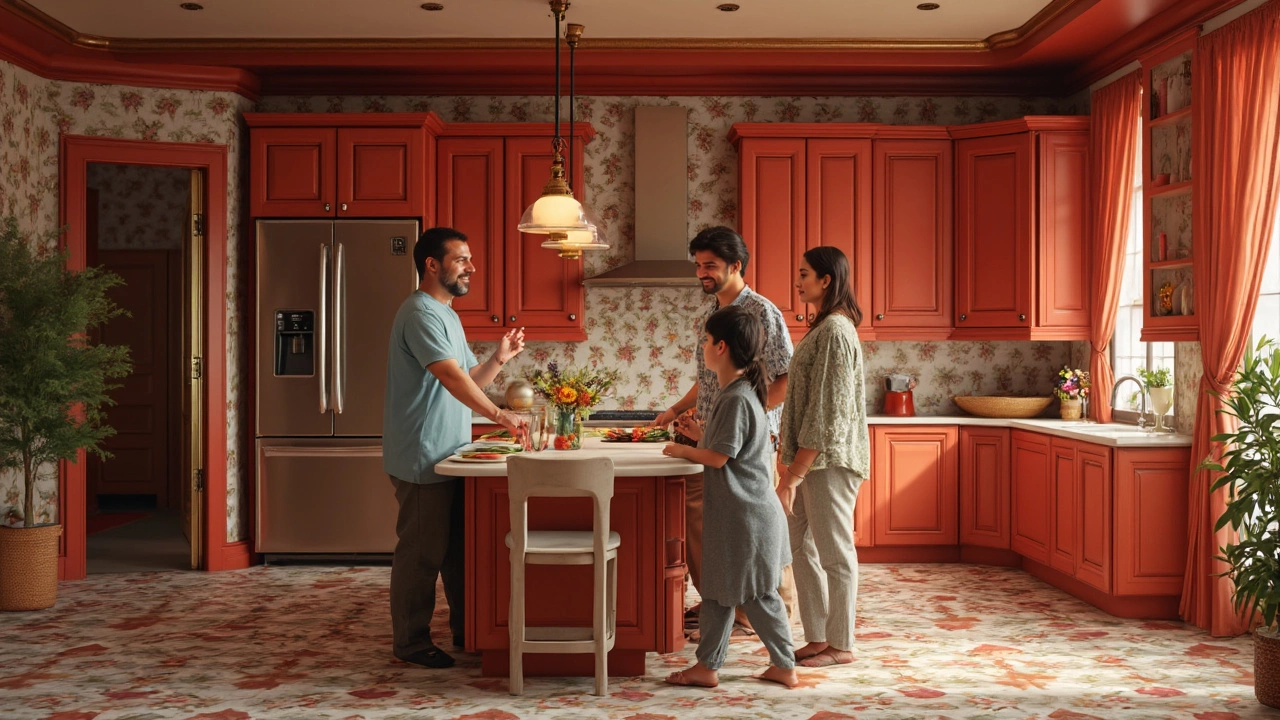When it comes to renovating a house, where do the dollars disappear the fastest? You might not be surprised to hear that kitchens and bathrooms are notorious for chewing through budgets like popcorn at a movie marathon. These areas are often at the top of the list for being both functional and eye-catching, but with that comes a hefty price tag.
Kitchens, for instance, require top-notch appliances, costly cabinetry, and durable countertops. All these together form the backbone of a dream kitchen but can easily become a nightmare for your wallet. Then there's the bathroom, packed with plumbing intricacies and slick surfaces, which means high costs for tiles and fixtures.
Beyond these rooms, don't underestimate the financial wallop of a new roof or major structural modifications. Re-roofing isn't just about sprucing up your home's top hat; it can involve significant logistics and labor, escalating the cost considerably. Structural changes, like removing walls to create an open floor plan, also involve serious cash and planning. And if you’re looking to combine spaces or alter the layout, expect to pay for professional know-how and possibly permits too.
- The Mystery of Kitchen Makeovers
- What Blows Up Bathroom Budgets?
- Don't Forget the Roof!
- The Real Deal with Structural Changes
- Smart Ways to Save and Spend Wisely
The Mystery of Kitchen Makeovers
Oh, the kitchen! The heart of the home and the bane of many wallets. When planning a home renovation, the kitchen often tops the list for complexity and cost.
Why Kitchens Cost a Bundle
First up, consider appliances. A top-of-the-line range or fridge can cost as much as a used car. But before raiding your savings, think about how you really use your kitchen. Do you cook all the time or is take-out more your style? Your lifestyle should guide your bling choices.
Cabinetry and Countertops
Then there's cabinetry—those kitchen workhorses that hold everything from cereal to fine china. Custom cabinetry can cost a fortune, so decide if you need those unique dovetail joints or if a quality ready-to-assemble option could fit the bill. As for countertops, materials like granite and quartz are sturdy but pricey. Laminate can be budget-friendly, keeping your kitchen remodeling costs in check.
Don't Overlook the Layout
Ah, but don’t forget the layout. Changing the layout means moving plumbing and electrical systems, which can add up quickly. Keep your sink and stove where they are if you want to save costs.
Lighting: The Overlooked Cost
Lighting can be a surprise expense if you haven't planned for it. Sure, a basic ceiling light can get the job done, but consider under-cabinet lighting for functionality.
Timing and Flexibility
On a side note, kitchen renovations can take weeks, even in the best-case scenario, so brace yourself for microwaved dinners in the living room for a while. Having a flexible timeline can ease the pressure on your finances and sanity.
A Quick Recap
| Element | Potential Cost Range |
|---|---|
| Appliances | $2,000-$15,000+ |
| Cabinetry | $5,000-$20,000+ |
| Countertops | $1,500-$6,000+ |
| Lighting | $200-$3,000+ |
| Layout Changes | Varies drastically |
A kitchen makeover isn't cheap, but keeping these tips in mind can help you make savvy decisions. Tackle the most costly renovations with both eyes open, and your kitchen could become both cost-effective and stunning.
What Blows Up Bathroom Budgets?
Thinking of giving your bathroom a facelift? Brace yourself! Bathroom renovations can make your budget balloon for quite a few reasons. It’s not just about changing tiles or getting new fixtures—it's about everything lurking beneath the surface too.
The Plumbing Predicament
One major culprit is plumbing. Whether you're upgrading or moving fixtures, all that pipework can cost a pretty penny. Older homes might need a full overhaul to adapt to new standards, adding to the expenses.
Fancy Fixtures and Fittings
Next stop on the budget-busting tour: fixtures and fittings. High-end showers, luxurious bathtubs, and fancy vanities can quickly add zeros to the end of your remodeling costs. Even if you’re not opting for gold-plated faucets, quality ones come with their own price tags.
Tiling Temptations
Tiling might look simple, but it's far from cheap. From intricate designs to basic waterproofing requirements, everything counts. The bigger the bathroom, the more you'll spend on materials and labor. And let’s face it, those intricate mosaic patterns look amazing but take more time and skill to install.
Additional Costs and Hidden Surprises
On top of these, you’ve got hidden costs like mold remediation or addressing water damage—issues that might not reveal themselves until you start tearing things apart.
| Bathroom Item | Estimated Cost Range |
|---|---|
| Fixture relocation | $1,000 - $5,000 |
| Luxury Soaking Tub | $1,500 - $8,000 |
| Full Tile Installation | $5,000 - $10,000 |
These figures show how prices vary dramatically based on choices and necessary requirements. So, while planning your bathroom overhaul, keeping an eye on what's behind that bathroom door before you start can save you from a significant budget shock!

Don't Forget the Roof!
Your home's roof is more than just a hat; it's a major player in keeping your castle safe and dry. Forgetting about the roof during a home renovation could lead to a big financial headache down the line. While not exactly glamorous, a solid roof isn't something you want to skimp on.
Cost of Re-Roofing
The cost of re-roofing can surprise many homeowners. On average, you're looking at spending around $5,000 to $10,000 for a standard-sized home. Why the hefty price tag? The type of materials used can dramatically affect costs. Asphalt shingles might be on the lower end, while slate or metal can skyrocket the price.
| Material Type | Average Cost Per Square Foot |
|---|---|
| Asphalt Shingles | $3 - $5 |
| Metal | $7 - $12 |
| Slate | $10 - $20 |
Why Roofing Matters
So why invest? The roof is your home's first defense against the elements. A durable, well-installed roof can last decades, meaning low maintenance and fewer repairs. Plus, a quality roof can boost your home’s energy efficiency by keeping the temperature consistent inside.
Roofing Tips
Before you dive into roofing repairs, here are some quick tips to keep in mind:
- Always get multiple quotes from contractors to find competitive pricing and reliable experts.
- Consider the climate. Certain materials fare better in specific weather conditions.
- Check for warranties offered by both roofing material manufacturers and installers.
A quality roof might cost more upfront, but think of it as buying peace of mind. It's like investing in summer vacations — you pay now, so you can relax later!
The Real Deal with Structural Changes
Thinking about knocking down a few walls or maybe adding an extension to your home? Structural changes can give your space a whole new vibe, but they aren't as simple as a paint job. These types of renovations often come with surprisingly high costs and a fair bit of complexity.
It’s not just about swinging a hammer and tearing down walls. You'll need to consider the bones of your house, which means diving into load-bearing walls, support beams, and sometimes even dealing with pesky permits. Depending on the scope of your project, you might need an architect to map out the plan and a structural engineer to ensure your home doesn't turn into a house of cards.
Planning Your Structural Changes
First things first, get a clear idea of what you want. Are you going open-plan to let light flood through the house, or maybe expanding a bedroom or garage? Whatever your vision, make sure to detail all structural modifications. This step not only guides the professionals but also helps avoid unexpected costs.
- Consult with professionals early in the process. A contractor or architect can help you get a realistic view of the cost and feasibility.
- Check what permits you might need. Local regulations can throw a wrench in your plans if not followed.
- Always have a contingency budget. Structural changes are notorious for surprise expenses, so it’s wise to set aside an extra 10-15% of your renovation budget.
Where Does the Money Go?
The bulk of the expense in structural renovations doesn't just come from the materials, though those cost a fair bit too. It's the labor, professional fees, and any additional work that might crop up unexpectedly. For instance, moving plumbing or electrical systems hidden in those walls you plan to remove can mean extra labor and cash.
Here's a quick glance at some potential costs:
| Task | Cost Range |
|---|---|
| Removing Load-Bearing Wall | $2,000 - $10,000 |
| Adding a New Room | $10,000 - $80,000+ |
| Permit Fees | $500 - $2,000 |
So, while getting more space or changing your home's layout can be amazing, it's crucial to be ready for what's involved. Armed with a solid plan and a bit of financial prep, you can transform your house without any nasty surprises.

Smart Ways to Save and Spend Wisely
Navigating a home renovation budget isn't just about making cuts; it’s also about knowing when to flex those financial muscles. If you've ever stared the budget beast in the eyes and wondered how to tame it, you're in the right spot.
Plan Like a Pro
First off, map out your entire project before any demolition begins. It's crucial. Design choices made in a rush, often under pressure, can lead to regrettable—and expensive—decisions. Make sure to get quotes from multiple sources for major expenses like plumbing and electrical work to avoid surprises.
Mix Materials
You don't need top-tier materials everywhere. Consider blending pricier items with budget-friendly alternatives. For example, use high-end tiles as a backsplash in the kitchen but more affordable flooring elsewhere. That way, you'll keep the aesthetics without blowing the budget.
Reuse and Recycle
If it ain’t broke, why replace it? Refinishing cabinets or repurposing old wood can give existing materials new life, saving money and the planet at the same time. Plus, explore architectural salvage shops—you might score fantastic, one-of-a-kind items at a fraction of the cost.
Prioritize High-Impact Areas
Sometimes it pays to spend big where it really matters—like cutting-edge appliances in the kitchen. Aim to impress with a few standout features, rather than spreading funds thinly across everything.
Monitor Your Money
Keep tabs on everything! A spreadsheet tracker can help you stay updated on your expenses and adjust as necessary. Remember that small expenses add up quickly; a little planning here can save significant cash.
DIY Where You Can
Got some free time and basic skills? There are plenty of tasks that don't require professional help. Painting, basic landscaping, and simple fixture replacements can be done without calling in the pros.
| Task | Potential Savings |
|---|---|
| Painting | $500-$1500 |
| Landscaping | $300-$700 |
| Fixture Replacement | $100-$400 |
By being strategic about where to splurge and where to save, your house will feel like a luxurious escape and keep your wallet healthy.

Written by Fletcher Abernathy
View all posts by: Fletcher Abernathy